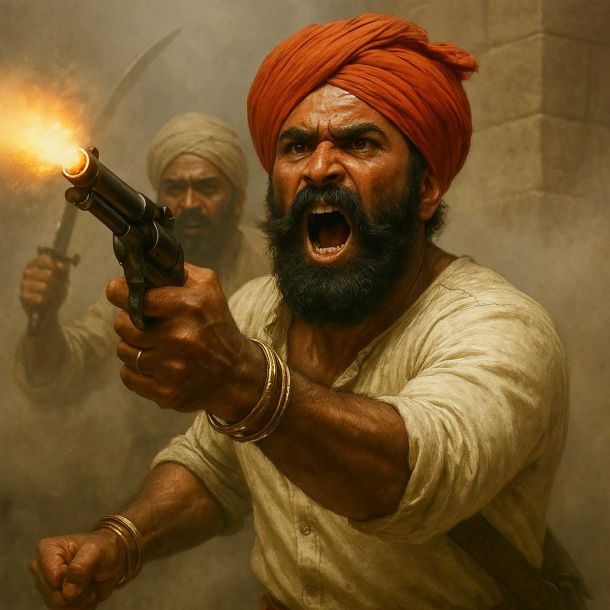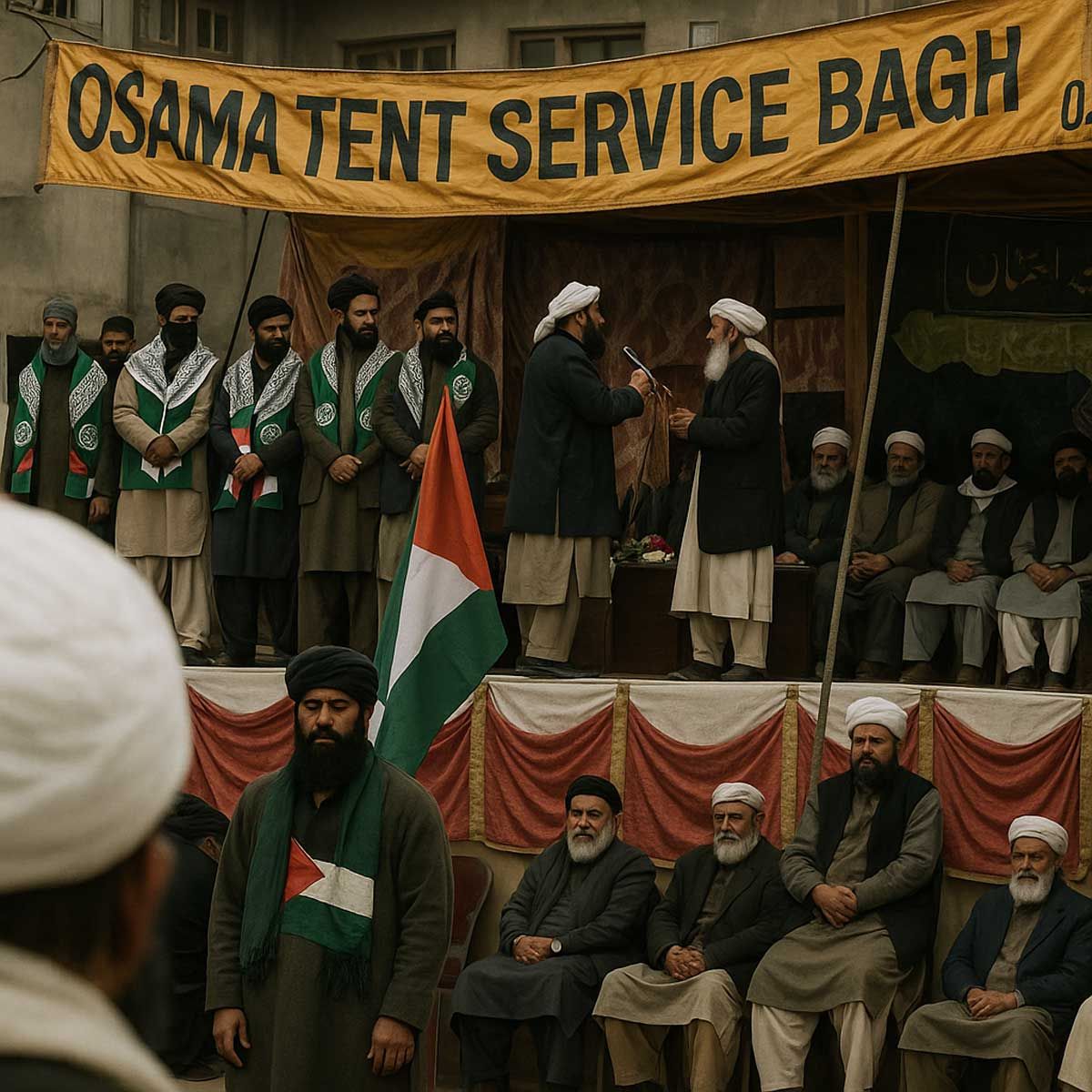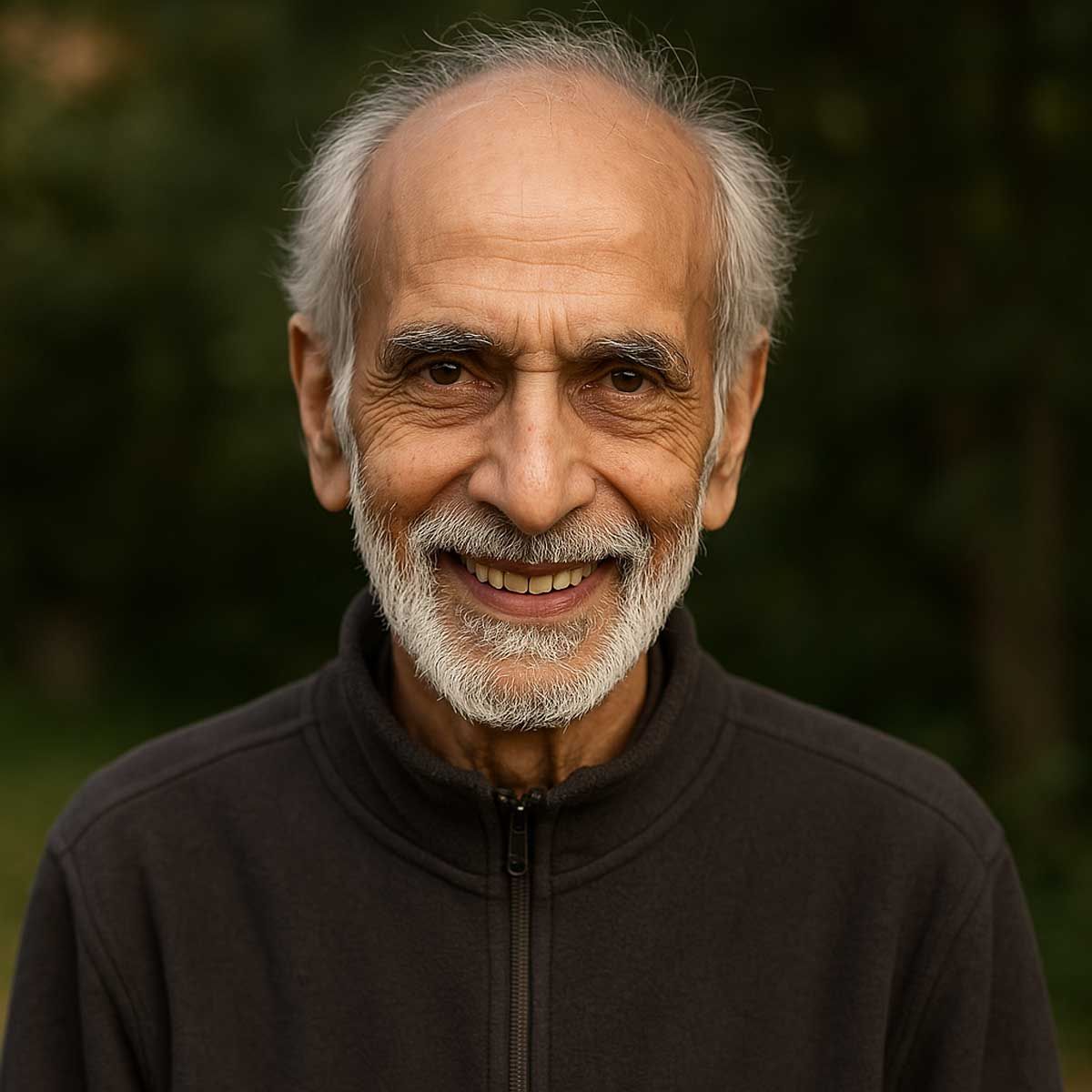Sanatan Articles
Satyaagrah
Written on
Satyaagrah
Written on
Satyaagrah
Written on
Satyaagrah
Written on
Satyaagrah
Written on
JOIN SATYAAGRAH SOCIAL MEDIA
“The blunders are all there on the board, waiting to be made”: Chess was born out of the India before 600s AD from 'Chaturanga' as a battle formation mentioned in Mahabharata, referring to 4 divisions of an army - elephantry, chariotry, cavalry & infantry

One of the oldest board games in history, the game of kings, Chess, is still a popular game and sport that intrigues millions across the globe. While there are many people who play chess, most players wouldn’t know who invented chess, how chess originated, and its intriguing history.
|
As interesting as the chess game is, the story of origin and the journey of chess over the years is something you shouldn’t miss. Read on to immerse yourself in the deep history of chess and how the game has developed through the centuries.
The popular game of chess dates back to nearly 1500 years when its earliest-known predecessor was called Chaturanga in India. The early forms of the game originated in India as Chaturanga – a four-player war game that included the key aspects of modern chess. The name comes from a battle formation mentioned in the Indian epic Mahabharata. Chaturanga refers to four divisions of an army, namely elephantry, chariotry, cavalry, and infantry. An ancient battle formation, akshauhini, is like the setup of chaturanga.
Chaturanga was played on a grid of 8×8 squares with pieces quite similar to that of modern chess. The rules of Chaturanga were similar to modern chess with few differences, such as limitations in rules for moving queens and bishops. The objective of chaturanga also seems to be somewhat different as players could win by capturing all of the opponent’s pieces besides the king.
The popularity of the game spread across the Asian continent to Persia, where the Rajah (the King piece) assumed the name of the Shah. The name of chaturanga was changed to chatrang in the 10th or 11th century.
The game further spread to the Islamic Arab world and Europe. It also found prominence in China, Japan, and other Southeast Asian countries, evolving into games such as shogi and xiangqi – Japanese and Chinese chess, respectively.
Chess was predominantly played in a Romantic chess playing style from the late 18th century, with quick and tactical movements.
Chaturanga was played on an 8×8 uncheckered board, called ashtāpada, which is also the name of a game. The board sometimes had special markings, the meaning of which is unknown today. These marks were not related to chaturanga, but were drawn on the board only by tradition. These special markings coincide with squares unreachable by any of the four Gajas that start on the board due to movement rules. Chess historian H. J. R. Murray conjectured that the ashtāpada was also used for some old race-type dice game, perhaps similar to chowka bhara, in which the marks had meaning.
An early reference to an ancient Indian board game is sometimes attributed to Subandhu in his Vasavadatta, dated between the 5th and 7th centuries AD:
The time of the rains played its game with frogs for pieces [nayadyutair] yellow and green in colour, as if mottled by lac, leapt up on the black field squares.
The colors are not those of the two camps, but mean that the frogs have two colors, yellow and green.
Banabhatta's Harsha Charitha (c. AD 625) contains the earliest reference to the name chaturanga:
Under this monarch, only the bees quarrelled to collect the dew; the only feet cut off were those of measurements, and only from Ashtâpada one could learn how to draw up a chaturanga, there was no cutting-off of the four limbs of condemned criminals...
While there is little doubt that ashtâpada is the gameboard of 8×8 squares, the double meaning of chaturanga, as the four-folded army, may be controversial. There is a probability that the ancestor of chess was mentioned there.
The game was first introduced to the West in Thomas Hyde's De ludis orientalibus libri duo, published in 1694. Subsequently, translations of Sanskrit accounts of the game were published by Sir William Jones.
In Arabic, most of the terminology of chess is derived directly from chaturanga: Modern chess itself is called shatranj in Arabic, and the bishop is called the elephant. The Tamerlane chess was also introduced in Iran later.
|
Chess History – Intriguing Ancient Legend
The history of the popular game of kings is highly debatable. There are numerous stories, legends, and guesses related to how chess originated. According to one of those interesting ancient legends, chess was invented by Grand Vizier Sissa Ben Dahir and gifted to the Indian King Shirham, also known as Shahram. Delighted by the gift, the king offered to reward him with anything he wanted, provided that it was reasonable.
The Grand Vizier requested just one wheat grain on the first square of the chessboard, followed by two on the second square, and four on the third, and continue to double the number on the successive squares until all the squares on the chessboard are filled with grains.
Underestimating the request of the Grand Vizier, King Shahram laughed at the request of a small gift and instantly asked someone to calculate how many wheat grains would be required. It took a week to arrive at the number, which shocked the King. The average number of grains that would fill up all the squares as per the Vizier’s request came to 18,446,744,073,709,551,615 grains which was equal to the harvest of several decades for the whole world.
The king ordered his men to fulfill the Vizier’s request and learned a lesson of never underestimating small things in life and hence, the pawns in chess.
|
Chess Theory and Development Through the 19th century
Chess, as we know it today, was born out of the Indian game chaturanga before the 600s AD. The game spread throughout Asia and Europe over the coming centuries and eventually evolved into what we know as chess around the 16th century. One of the first masters of the game was a Spanish priest named Ruy Lopez. Although he didn't invent the opening named after him, he analyzed it in a book he published in 1561. Chess theory was so primitive back then that Lopez advocated the strategy of playing with the sun in your opponent's eyes!
Chess theory moved at a snail's pace until the mid 18th century. In 1749, the French Master Francois-Andre Philidor stepped onto the scene with his book titled Analyse du jeu des Échecs. This book covered some new opening ideas (including the defense which still bears his name), and also contained Philidor's famous defense in rook and pawn endgames - an endgame technique that is still used today. Philidor's famous statement that "The pawns are the soul of chess" was first introduced to the world in this book.
Chess continued to gain popularity throughout the world, and in the mid 19th century the standardization of chess sets occurred. Before the 1850s, chess sets weren't uniform at all. In 1849, Jaques of London (a manufacturer of games and toys) introduced a new style of pieces created by Nathaniel Cooke. These same pieces were endorsed by Howard Staunton, the strongest player of his time. This new style of pieces, known as the Staunton pattern, became instantly popular and were used in tournaments and clubs all over the world. The Staunton pieces, and minor variations of it, are still considered to be the standard for tournament chess sets.
The 19th century also marked the introduction of chess clocks to competitive play. Before chess clocks became the norm, a single game could last up to 14 hours! With the standardization of chess sets and introduction of chess clocks, the equipment needed for modern matches and tournaments were set in place.
Chess, itself, was developing greatly during the 1800s. The most famous games of this time period were swashbuckling attacking games - strong defensive ideas hadn't been learned yet. If a player wasn't sacrificing their pieces right and left trying to checkmate their opponent in a violent manner, then it wasn't a fun game! It was during this attacking era in chess that the American player Paul Morphy entered the scene.
 Paul Morphy, the embodiment of romantic and aggressive play. Photo: Wikipedia |
Morphy was the embodiment of all of these romantic and aggressive attacking ideas. During his tour of Europe, Morphy soundly trounced every major player in the world except Howard Staunton (who was past his prime and didn't accept Morphy's challenge). Morphy steamrolled Adolf Anderssen, Louis Paulsen, Daniel Harrwitz, and a host of other masters. In 1858, the famous "Opera House" game was played by Morphy vs the allies (the Duke of Brunswick and a French Count), and is considered one of the best games of all time. Morphy throws everything, including the proverbial kitchen sink, at his opponents. A beautiful game for the ages!
The First World Champions and the Advent of Positional Chess
Wilhelm Steinitz never played Morphy, who had retired from the game by the time Steinitz rose to prominence. Steinitz's theories about the game are still widely felt today, especially his disdain for overly-aggressive play. He preferred to accept the popularly offered gambit pawn, and then closed the position down in order to grind out a win. Steinitz initially had no equal in this kind of positional play and used it to become the first official world champion in 1886.
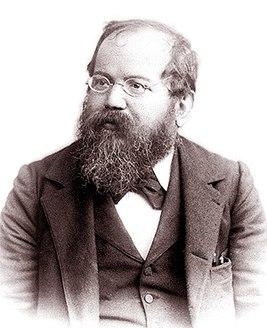 Wilhelm Steinitz, the first official world champion. Photo: Wikipedia |
Steinitz held the title of world champion until 1894 when Emanuel Lasker soundly defeated him (10-5). Their rematch, three years later, was even more lopsided: Lasker won 10-2. Lasker would hold the title for 27 years, by far the longest reign of any chess world champion.
Positional chess, as Steinitz and Lasker displayed, now became more and more popular. The prevailing theory until about the 1920s was to occupy the center of the board during the opening, usually with pawns. The most common openings were the Ruy Lopez, the Giuoco Piano, the Queen's Gambit, the French Defense, and the Four Knights' Game. These are relatively quiet openings from which both sides slowly try to accumulate small advantages in space, key squares, diagonals, and files.
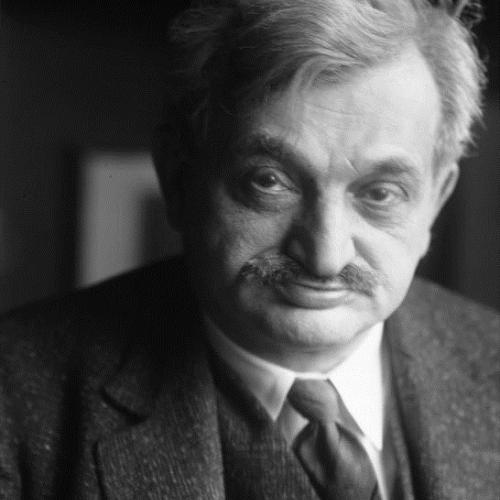 Emanuel Lasker, the second world champion. Photo: German Federal Archive, CC |
Jose Raul Capablanca defeated Lasker in 1921 to become the third world champion. Capablanca's style is still considered the epitome of simple, clear-cut positional mastery. He tended to avoid complex tactical situations, and instead would seize a seemingly small advantage that he would convert in the endgame. His endgame skill was considered the greatest the world had ever seen. Even today, the best chess engines find very few errors in Capablanca's endgame technique. Although he only held the title of world champion for 6 years, Capablanca is still considered to be one of the greatest players of all time.
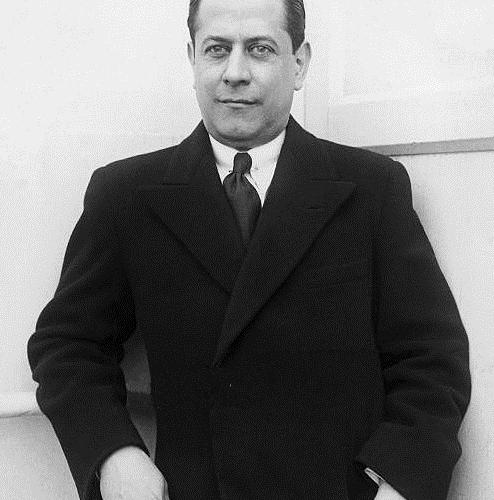 Jose Raul Capblanca, the third world champion. Photo: |
In the 1920s, a new school of thought entered top-level chess - hypermodernism. The main idea is to control the center with minor pieces instead of merely occupying it with pawns. These new ideas were highlighted in the games and theories of a new generation of top talent: Aron Nimzovich, Efim Bogolyubov, Richard Reti, and Ernst Grunfeld. In this period, new openings and development schemes were formed in many popular openings, like the Indian Defenses, the Grunfeld, and the Benoni.
Perhaps the most hypermodern of all openings is Alekhine's Defense (named after the fourth world champion, Alexander Alekhine). The point of this defense is to invite white to advance his central pawns, and subsequently attack the overextended center. Today Alekhine is remembered not so much as a hypermodern player, but as the first dynamic style player - he could play extremely tactically and aggressively, or quietly and positionally. He held the title of world champion from 1927 until 1935 when he lost the title to Max Euwe. Alekhine won the return match in 1937 and held the title until his death in 1946. He is the only chess world champion to pass away while holding the title.
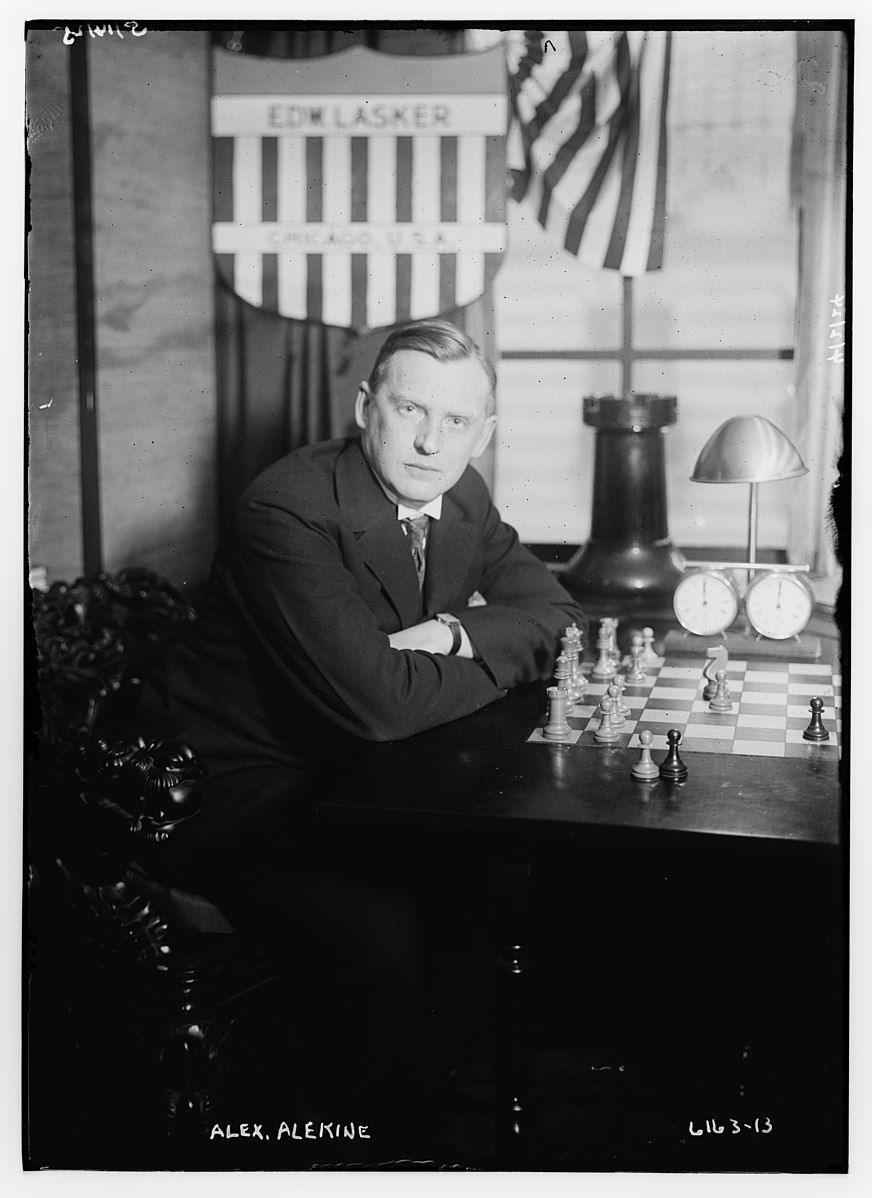 Alexander Alekhine, the fourth world champion. Photo: George Bain/Library of Congress, Wikipedia |
Soviet Dominance in the 20th Century
From 1927-2006, players from the Soviet Union and Russia held the world championship title (with only two exceptions). Alekhine, Mikhail Botvinnik, Vassily Smyslov, Mikhail Tal, Tigran Petrosian, Boris Spassky, Anatoly Karpov, Garry Kasparov, and Vladimir Kramnik were the world champions and chess giants that proved the domination of the title in the 20th century and early 21st century. The styles of the above-mentioned chess legends couldn't be more different. From the positional champions (Karpov, Petrosian, Smyslov, Kramnik), to the extremely ferocious attacking style of Tal, to the dynamic abilities of Alekhine, Botvinnik, and Kasparov - there is something for everyone!
After Alekhine, Mikhail Botvinnik became the next world champion by winning the 1948 world championship. This event was notable as it marked the first time that FIDE would oversee the world championship event (something they still do today), but also because it was the first time that the world championship wasn't decided by a single match (a quintuple match system was used in the absence of a reigning world champion). Botvinnik would hold the title of world champion from 1948 until 1963 (with two exceptions, each lasting one year).
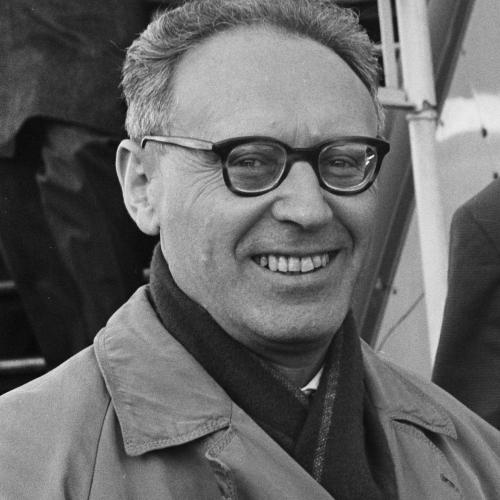 Mikhail Botvinnik, the sixth world champion. Photo: Harry Pot/Dutch National Archives, CC Mikhail Botvinnik, the sixth world champion. Photo: Harry Pot/Dutch National Archives, CC |
Botvinnik was known for his iron logic and dynamic abilities, being able to change styles almost like a chameleon depending on who his opponent was. Botvinnik lost the title to Vassily Smyslov in 1957, but according to the rules at the time Botvinnik was able to get a rematch in the following year. In the 1958 rematch, Botvinnik defeated Smyslov and regained the title. In 1960, Botvinnik lost the title to Mikhail Tal. However, in 1961 Botvinnik won the rematch vs Tal. It wasn't until 1963 (when Botvinnik lost a match to Tigran Petrosian) that he could no longer demand a rematch the next year, as FIDE had changed the rules.
After his long reign as world champion, Botvinnik was perhaps the most decorated chess trainer of all time. He trained three future world champions (Karpov, Kasparov, and Kramnik), a feat nobody else can claim. He was also a computer scientist, and is considered to be one of the fathers of computer chess.
Tigran Petrosian became the 9th world champion, after defeating Botvinnik in 1963. He played in a positional style, and was known for wonderful exchange sacrifices. Petrosian defended his title by defeating Boris Spassky in 1966. Three years later, Spassky won the candidates cycle again and faced Petrosian for the title for a second time in 1969. Spassky defeated Petrosian in the 1969 match to become the 10th world champion. Spassky would hold the title for three years, before losing the famous match to Bobby Fischer.
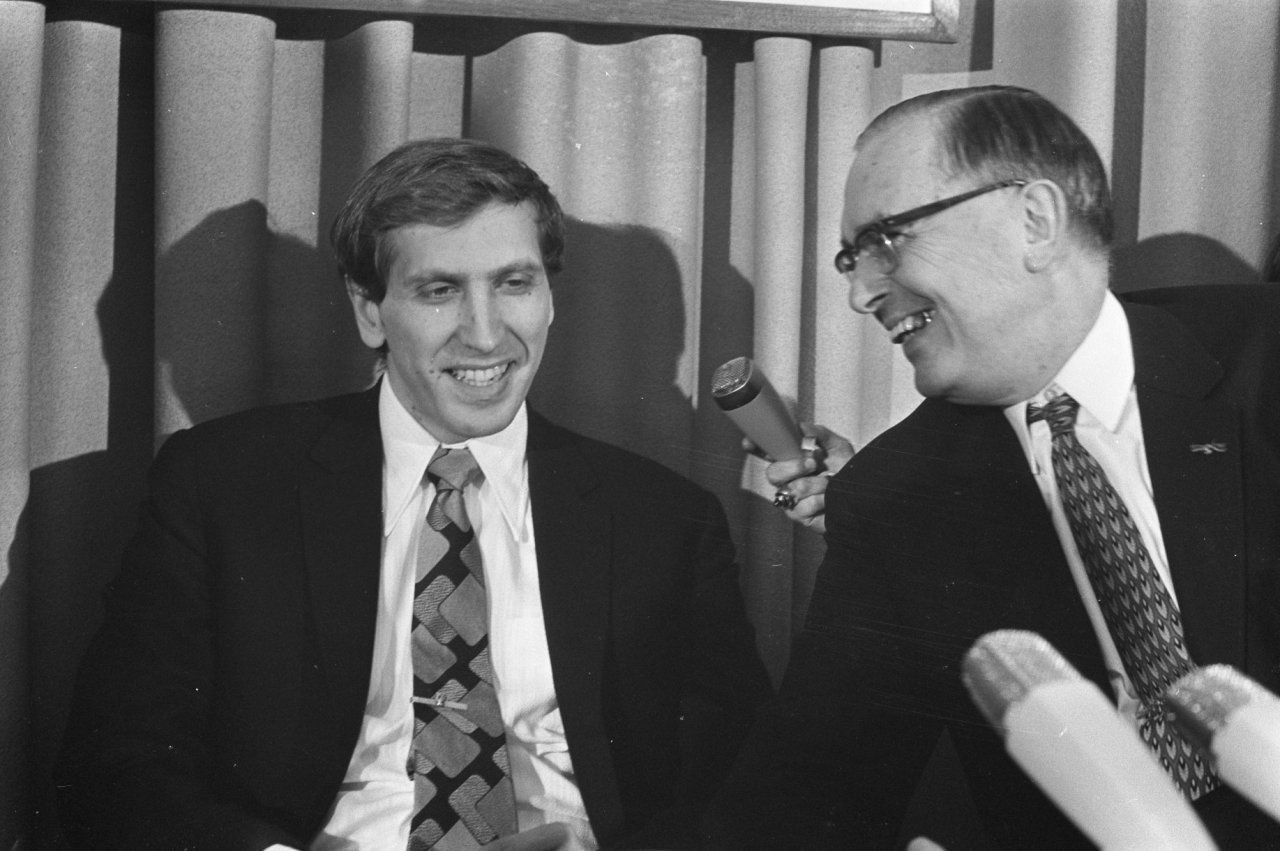 Bobby Fischer with Max Euwe in 1972. Photo: Bert Verhoeff/Dutch National Archive, CC |
Bobby Fischer was one of the most enigmatic chess figures of all time, and the only player able to break down the Soviet chess wall in the second half of the 20th century. From 1970-1972, it seemed like there was no one on Earth who could stop him. In 1971, he defeated Mark Taimanov in a Candidates' Match of first to six wins. Fischer won the first six games, without a loss or draw. Then a few months later he did the same thing again to Bent Larsen, scoring 6 wins in a row. These two accomplishments were unprecedented.
In 1972, Fischer and Spassky played the match that captivated the entire world, even people who knew nothing about chess. This was not only viewed as the most anticipated world chess championship event of all time, but it had great geopolitical ramifications as well. The US and Soviet Union were not only fighting the Cold War, but were also fighting for chess supremacy. Fischer was extremely difficult to work with, losing the first game by a very strange elementary blunder in a drawn endgame. He then refused to play the second game because of problems he perceived in the playing hall. Spassky began the match with a 2-0 lead, putting Fischer in a big hole. The match was the best of 24 games, and Fischer mounted one of the greatest comebacks of all time - soundly winning by a score of 12.5 to 8.5. There are many famous games from this match, but game six stands out - even Spassky gave Fischer a standing ovation after the following game:
Unfortunately for chess history, Fischer refused to defend his title three years later. Due to Fischer's seemingly ridiculous demands that FIDE could not grant, he was forced to vacate the title of world champion. Fischer disappeared from the chess world until resurfacing in 1992 to play a match with his old rival, Boris Spassky. After winning that match, Fischer again disappeared from the chess scene - leaving behind more question marks than any other world champion.
Karpov, Kasparov, Computers, and Carlsen
Anatoly Karpov became the 12th world champion in 1975. He is known for his solid positional style and fantastic technique, which has been described as a boa constrictor. Former World Champion Viswanathan Anand states that "Karpov isn't so interested in his own plan, but he will keep on foiling yours". Karpov reigned as the world champion for ten years and was extremely active at the highest level of chess until around 1997. Later in his career, several books were published under his name, and he became very active in Russian politics.
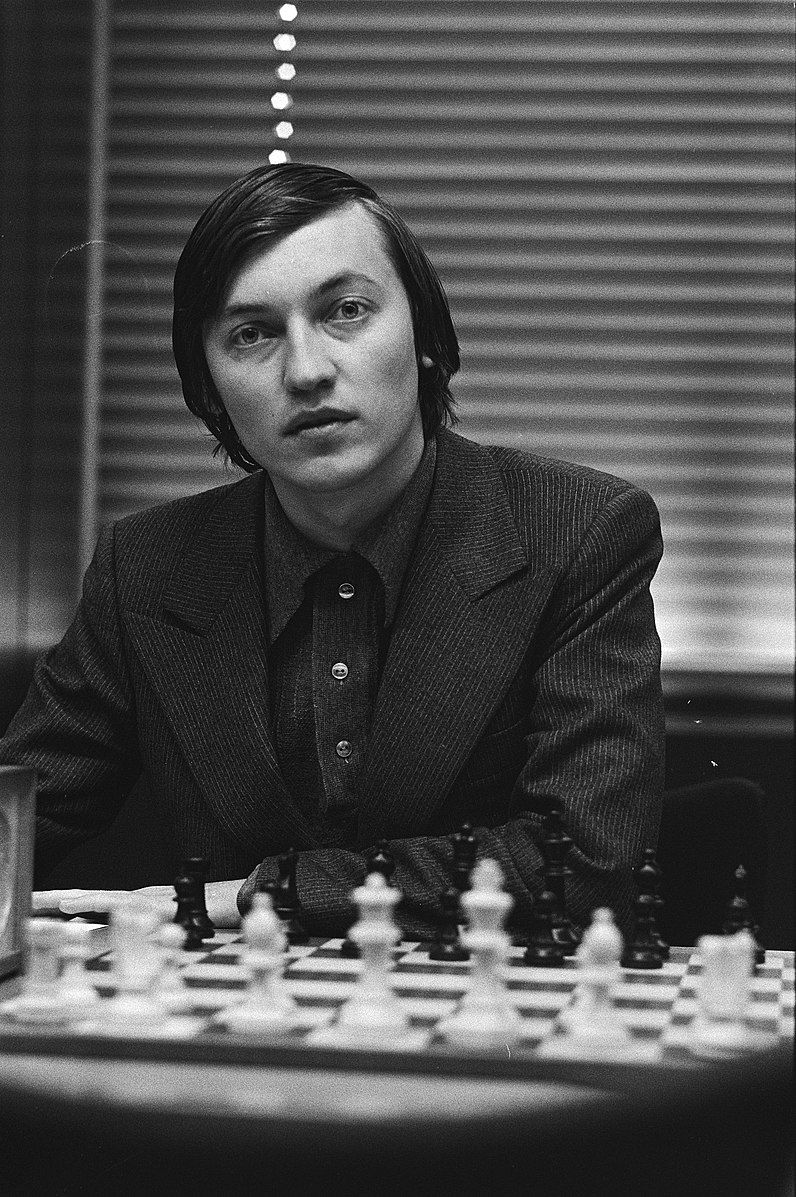 Anatoly Karpov, the 12th world champion. Photo: Rob Croes/Dutch National Archive, CC |
Karpov's dominance in the 1970s and 1980s wasn't overcome until the emergence of another Russian Legend, Garry Kasparov. In 1984, the first of five Karpov-Kasparov world championship matches occurred. These two chess legends played a total of 144 games for the world championship title in the previously mentioned five matches. Out of these 144 games, 104 were draws, Kasparov had 21 wins, and Karpov had 19 wins. Despite these almost identical match records, Kasparov won every match vs Karpov.
Kasparov would hold the belt for 15 years, the second longest uninterrupted reign after Lasker's 27. Chess theory had advanced greatly between the early 20th century (Lasker's reign) and the late 20th century. Due to the evolution of chess theory, Kasparov not only had more world class opposition, but considerably stronger opposition when compared to Lasker. Kasparov consistently remained head and shoulders above all competition until he was dethroned by Vladimir Kramnik in 2000. Kasparov was not past his prime in the match versus Kramnik, just strangely out of form. He remained the highest rated player in the world until 2005, becoming the first person ever to breach 2800 Elo.
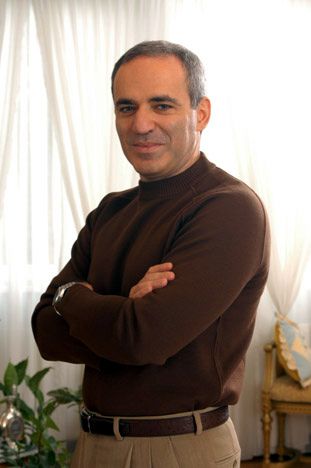 Garry Kasparov, the 13th world champion. Photo: Owen Williams/ The Kasparov Agency, CC |
Kasparov was the first major player to heavily use computers for preparation and study of the game, and he defeated the strongest computers of the late 1980s and early 1990s in several highly publicized matches. He was finally defeated by the supercomputer Deep Blue in 1997, the first time a computer had defeated a world champion in a match that changed the world. Kasparov has always mantained that human collusion was involved in helping the computer select the correct move at crucial moments. Deep Blue was dismantled after the match. After retiring from competitive chess, Kasparov wrote several fantastic books (including his wonderful multi-volume work My Predecessors), and became involved in Russian politics. He recently did the Master Class series on chess, which he discussed in this chess.com exclusive interview:
In 2005, computers were finally seen as much more powerful than any human could ever become. This was due to a supercomputer, Hydra, easily defeating Michael Adams (ranked seventh in the world at the time with a rating of 2737). Hydra won the match with a 5.5 points out of 6 games. Computer engines continued to get stronger and stronger. A popular open source engine, Stockfish, has an estimated ELO of around 3400. In 2017, a new entity in the chess world, AlphaZero, soundly defeated Stockfish in a 100 game match. In early 2018, AlphaZero defeated Stockfish again - this time in a 1,000 game match with time odds.
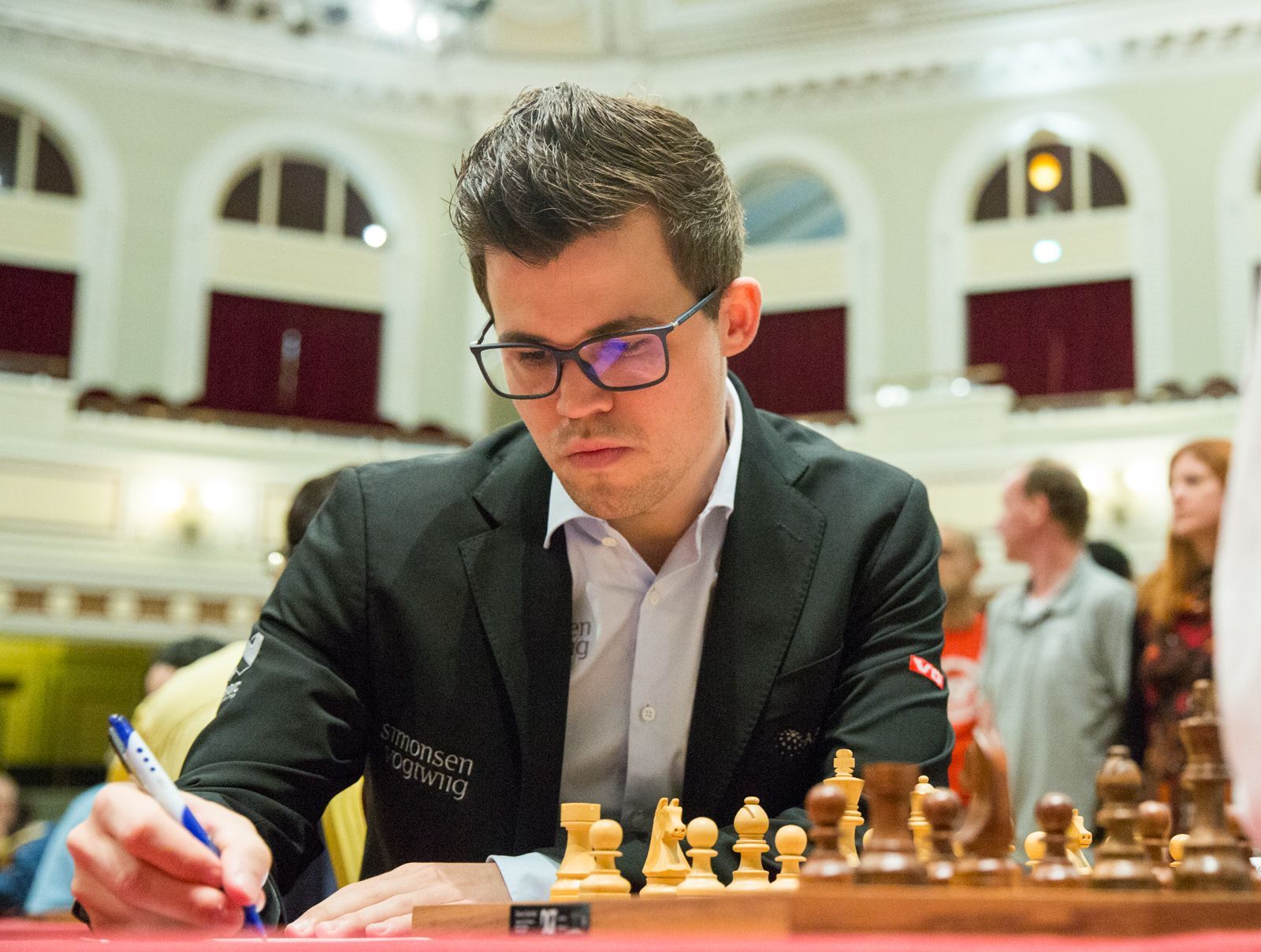 Current World Champion Magnus Carlsen at the Chess.com Isle of Man (2017). Photo: © Maria Emelianova/Chess.com |
Humans are also becoming stronger with the help of computers for analysis, research, and opening theory. Nowadays, almost every chess player uses chess engines, including current World Champion Magnus Carlsen. Carlsen has been the reigning world champion since defeating Viswanathan Anand in 2013, and has remained the highest rated player in the world for a long time. He continues his dominance, and won the first 4 tournaments he played in 2019. He holds the record for highest rating in history at 2882 (attained in 2014), and currently holds a classical rating of 2876. Many people already consider him to be the strongest player of all time.
References:
 Support Us
Support Us
Satyagraha was born from the heart of our land, with an undying aim to unveil the true essence of Bharat. It seeks to illuminate the hidden tales of our valiant freedom fighters and the rich chronicles that haven't yet sung their complete melody in the mainstream.
While platforms like NDTV and 'The Wire' effortlessly garner funds under the banner of safeguarding democracy, we at Satyagraha walk a different path. Our strength and resonance come from you. In this journey to weave a stronger Bharat, every little contribution amplifies our voice. Let's come together, contribute as you can, and champion the true spirit of our nation.
 |  |  |
| ICICI Bank of Satyaagrah | Razorpay Bank of Satyaagrah | PayPal Bank of Satyaagrah - For International Payments |
If all above doesn't work, then try the LINK below:
Please share the article on other platforms
DISCLAIMER: The author is solely responsible for the views expressed in this article. The author carries the responsibility for citing and/or licensing of images utilized within the text. The website also frequently uses non-commercial images for representational purposes only in line with the article. We are not responsible for the authenticity of such images. If some images have a copyright issue, we request the person/entity to contact us at This email address is being protected from spambots. You need JavaScript enabled to view it. and we will take the necessary actions to resolve the issue.
Related Articles
- Freedom struggle of Gurjars against Britishers at Koonja in 1824: 100s of Gurjars Martyred and 100s Hung in Single Tree
- The Residue of Christianism - Hindu Society Under Siege
- Kartar Singh Sarabha - The Freedom fighter who was Hanged at the age of 19 and inspired Bhagat Singh
- 16 year old freedom fighter Shivdevi Tomar, who killed 17 Britishers and wounded many
- Tirot Singh: An Unsung Hero of the Khasi Tribe who destroyed British with his skill at Guerrilla Warfare
- Fearless female sniper Uda Devi, who etched history during the Siege of Lucknow!
- Our first true war of independence lie forgotten within the fog of time and tomes of propaganda: Sanyasi Rebellion, when "renouncers of the material world" lead peasants in revolt against British and fundamentalist islamic clans
- The Eki Movement of hero Motilal Tejawat whose last wish is still waiting to be fulfilled - 100 years of Palchitaria massacre in Gujarat and its cover-up by the British govt
- The United Front of Hostile Forces - Hindu Society Under Siege
- Anuj Dhar claims that Subhas Chandra Bose was suspected of being ‘poisoned’ after ouster from the post of Congress president
- "When we bring what is within out into the world, miracles happen": Built by the Rajput king Sawai Jai Singh II in 1734, UNESCO World Heritage site Jantar Mantar, Jaipur is an astronomical observatory, which features the world’s largest stone sundial
- ‘The Koh-i- Noor’ or “Two and half days’ food of the entire world” as valued by Mughal Emperor Zahiruddin Muhammad Babur is one Gem in a history that is not known to have ever been bought or sold, it always changed hands as a result of conquest
- How Britishers were challenged by 83 year old Ropuiliani in Mizoram in 1892-’93
- "Loyalty to petrified opinion never yet broke a chain or freed a human soul": The First PM of India, Jawaharlal Nehru in 1956 took Freeman's oath "to be true to the Queen of England", and was given documents of the Freedom, contained in ornamental caskets
- Maligning of India by British Raj since the 1800s



